3D animation pipeline
The process of creating a 3D animation is much more complex than most people think. The number of steps to produce a 3D animated piece can vary to a great extent, depending on the animation studio involved and the scale of the project itself.
But generally, a lengthy list of tasks must be checked in the 3d animation studio and a large group of people with different skill-sets must be engaged for a 3D animated video or feature film to be produced. In order to push such a complicated process forward efficiently and affordably, a solid structure and a detailed framework are needed: 3D animation pipeline.
What is an animation pipeline?
Animation workflow or pipeline is a system consisting of people, hardware, and software aligned to work in a specific sequential order to do pre-determined tasks in a pre-determined time frame, which will lead to a 3D animation product or asset as the final output.
The final product could be a traditional animation such as a feature film, short film, animated commercial video, television show, game trailer, or video game asset, or it could be something totally different. It’s much like an assembly line for 3D animated video production.
Recently, more animation studios have been using 3d animations in their transmedia storytelling projects. If you’re new to the topic, we recommend reading our what is transmedia storytelling article before moving on to the next part.
Here at Dream Farm Animation Studios, the following pipeline is used for the majority of 3D animation projects:
Key components of CGI animation pipeline
3D animation production pipeline has three main stages:
- Pre-production
- Production
- Post-production
Based on organizational considerations, resources, outcomes, and other factors, each segment of the 3D animation industry uses the three stages a little differently, but the main structure remains intact. The specifics of each project’s pipeline may also be slightly different. However, the three main stages remain the same again.
1- What is pre-production in the animation pipeline?
Pre-production is the research, designing, and planning phase of the entire 3D project, which is split between two teams: The design team creates the idea, story, and designs, and the management team, who writes down the production plan (including budgets, teams, and time frames). The better the pre-production phase is done, the easier the production stage will be.
Pre-production consists of the following steps:
-
Idea Generation:
Every great story starts with a brilliant idea. Thus, it is essential for a successful animation to have a solid, well-thought idea.
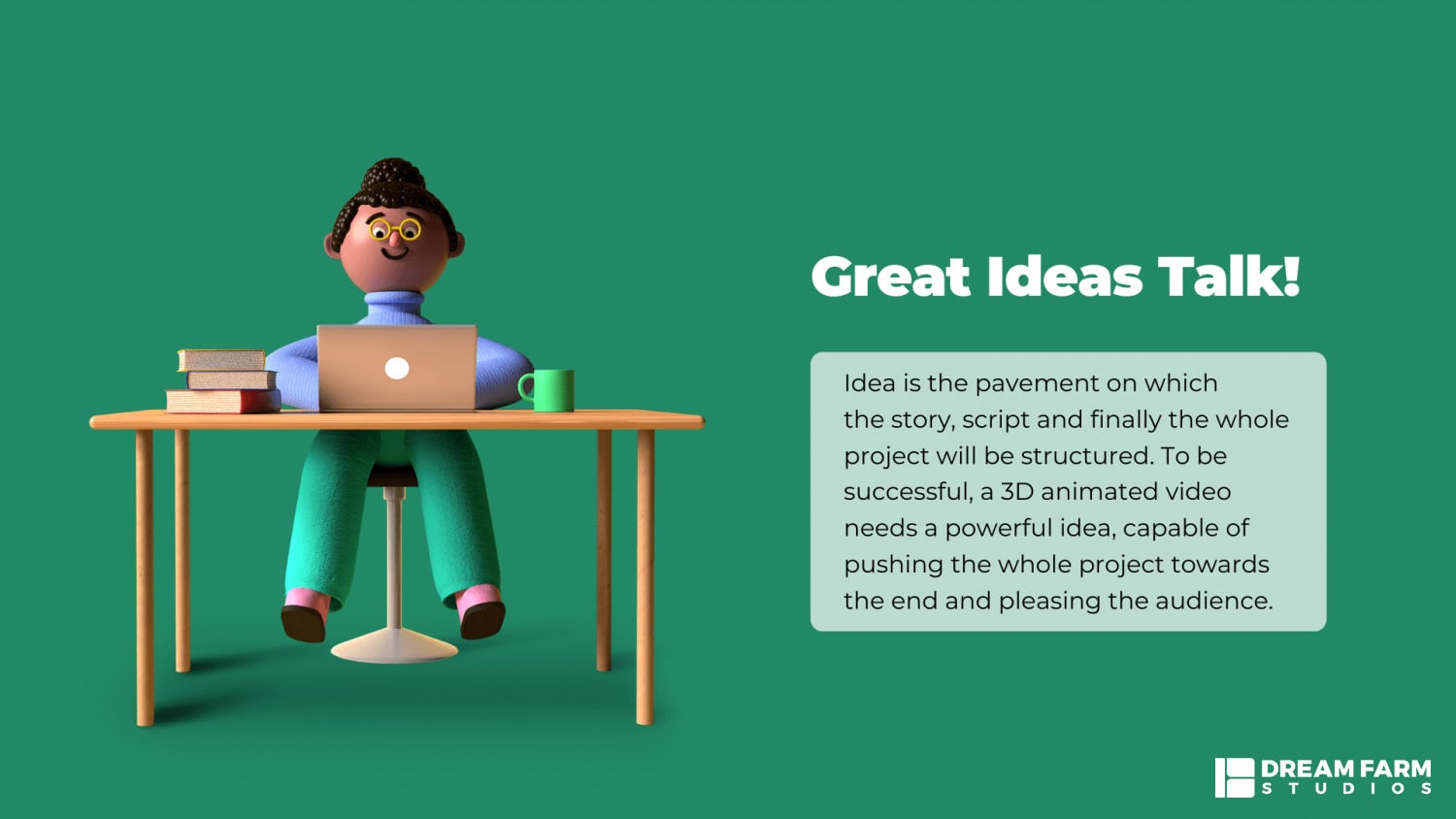
-
Story Creation:
Ideas will be developed and improved until the whole story is shaped. This is a basic version of what’s going to happen in the animation, including the characters, conflict, et cetera.
An insider’s guide on writing the perfect story for a 3D animation
-
Script Writing:
The script is the formal, written, literary version of the story; including the character movements, environment, time, actions, and dialogues.
-
Storyboarding:
A storyboard is a non-moving visual version of the script. It basically looks like a comic book, including early ideas of camera staging, major character poses, or scene events.
-
Animatic:
A moving form of the storyboard is called the animatic which will evolve into the final edit of the entire project. The animatic is created in its most simple form, portraying the sequence timing of the project through 2D storyboard drawings.
-
Design:
The final look of the project is decided at this stage; including the concept design, character design, costumes, prop design, and environment. The mood and the concept of designs must be fully conveyed here. If you want to know the ins and outs of character design, check out the article about shape language in character design.
Read more to find out what we talk about when we talk about design in animation pre-production.
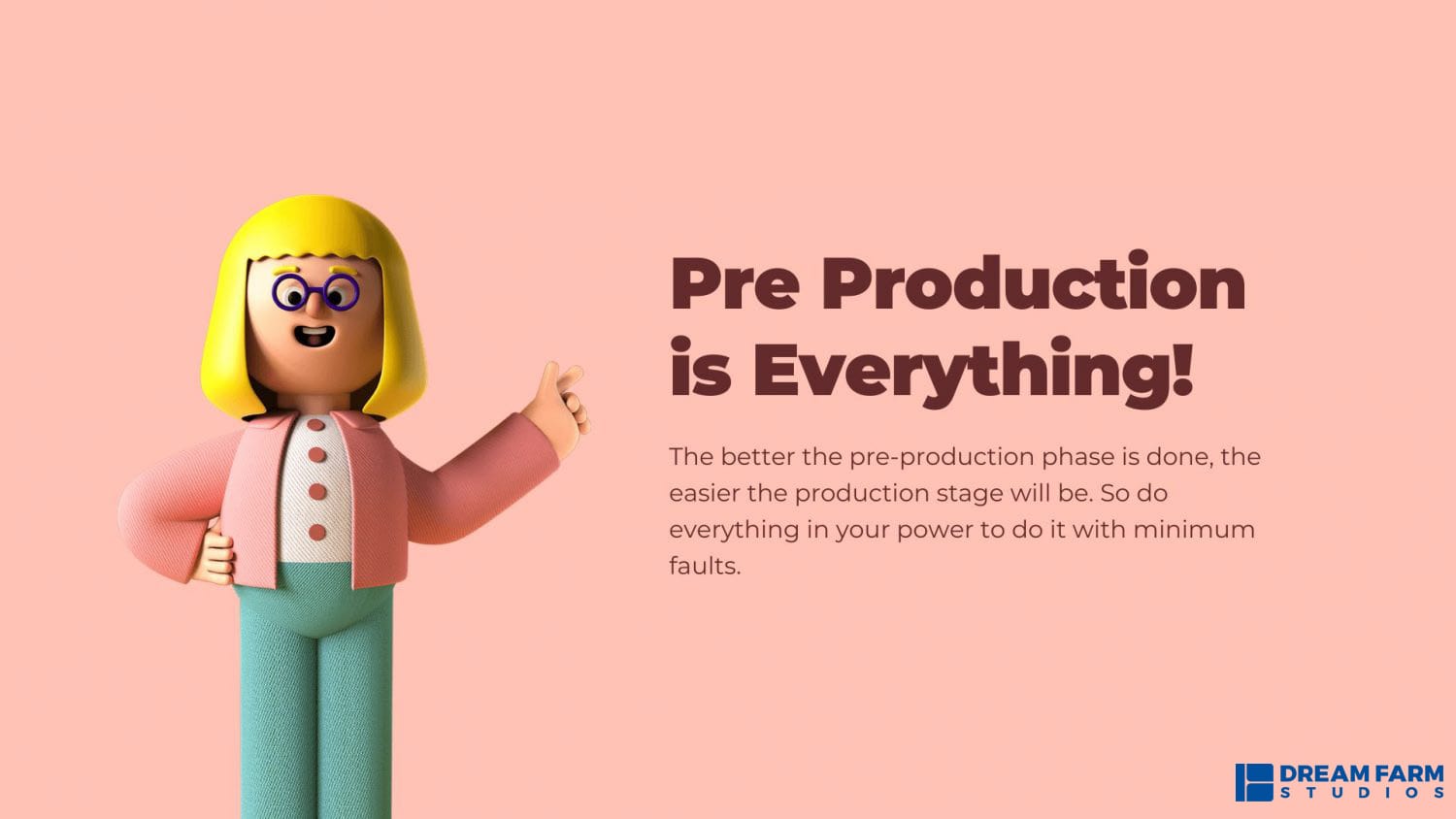
2- What is the 3D animation production process?
The production stage is where all previous efforts must pay off and transform into action. At this stage, visual elements of the 3D animation will be handed out to the designated teams and artists. Team leaders make sure time frames, and quality matches those of the determined plan in the pre-production stage and goes as smoothly as possible. The outcome of this stage shapes the entirety of the 3D animation.
The production stage consists of the following steps:
-
3D Layout:
Simply put, a 3D version of the 2D animatic is called a 3D layout. The 3D layout contains basic 3D attributes such as the characters’ size, shape, environment, a simple animation of the characters, proxy geometry, et cetera.
Curious to know more? Here you can find out what exactly a 3D animation layout is and why it matters with an example.
-
3D Modeling:
3D modeling is the process of developing a geometric surface representation of any object in a specialized 3D software such as Maya or 3Ds Max.
Here’s a quick guide to 3D modeling you can take a look at for more.
-
3D Texturing:
The process of creating and applying textures (colors and surface properties) to a 3D model is called 3D texturing. Before coming to the texture artist, 3D models are usually in a default shaded flat color.
For more information, you can take a quick look at texturing in 3D animation production. If you want to get a more in-depth guide on how to use color, check out the color theory in character design.
-
3D Rigging:
During the rigging process, a bone structure is put into the 3D object so that the animators can move different parts of the geometric object (in character rigging, for example) as quickly and efficiently as possible.
-
3D Animation:
The movements of the 3D objects or characters in a scene or setting are created during the animation stage. Animation is usually the most crucial and time-consuming part of producing a 3D animated video.
Interested in learning to animate? Check out Animation Mentor’s Ultimate Guide to Animation for Beginners
-
VFX:
A 3D animator animates almost everything, but elements like hair, fur, water, fire, clothes, or dust; key-framing them would be too difficult or even impossible.
These elements are created during the VFX component of the pipeline; there are things you might not know about the visual effects stage in 3D animation production.
-
Lighting:
Just like real-world lighting in photography or filming, 3D animation lighting is the stage at which the mood of a 3D scene or sequence is created through light based on the pre-production designs.
For more information, you can take a look at The ultimate guide to lighting fundamentals for 3D.
-
Rendering:
When dealing with a 3D animation, every scene is separated and rendered into multiple layers, including objects, colors, background, foreground, shadows, highlights, et cetera. The layers are going to be united again in the post-production stage (Compositing).
If you are curious to find out more, take a look at The final step in 3D animation production: 3D Rendering
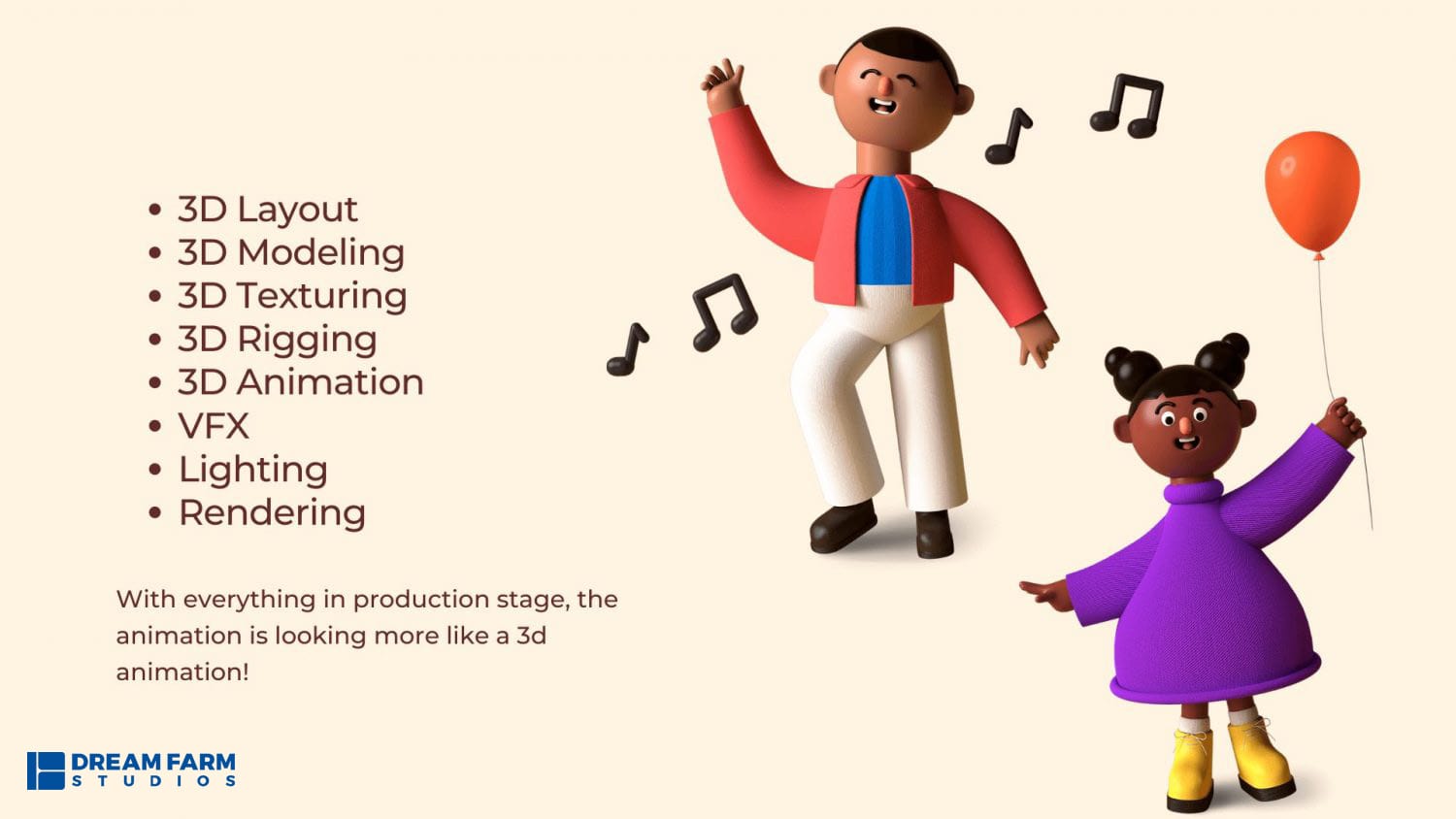
3- What is the animation post-production process?
At this stage, the final touches are added to the project to make it look polished and professional (the definition of polished and professional might differ in various projects, of course). Post-production artists have a number of tools that can make up the look of a project in whatever way they want.
Post-production in the 3D animation pipeline includes:
-
-
Compositing:
To make a final output, the layers rendered previously are put together again in compositing. The layering process can be as simple as putting 2 layers together or as complex as matching hundreds of layers and adjusting their properties.
You can get more familiar with Compositing in animation.
-
2D VFX:
Some visual effects, such as sparks, dust, raindrops, camera shakes, et cetera, are more easily achieved in a 2D environment at the end of the project without sacrificing the quality. These effects are usually mixed with other layers in compositing.
Take a quick look at the 2D VFX component of the 3D animation workflow for more on the subject.
-
-
Color correction:
Also known as color timing or color grading, color correction is literally the last adjustment we make to a 3D animation in the pipeline. This step makes each shot and the whole project look more consistent.
Read more: A quick look at color correction in 3D animation production.
-
Final output:
There are different options out there regarding the output format of the pipeline. However, the most common type is a digital video which is compatible with most digital devices and can be played on the internet.
Here is a short guide on choosing the right format for a video file.
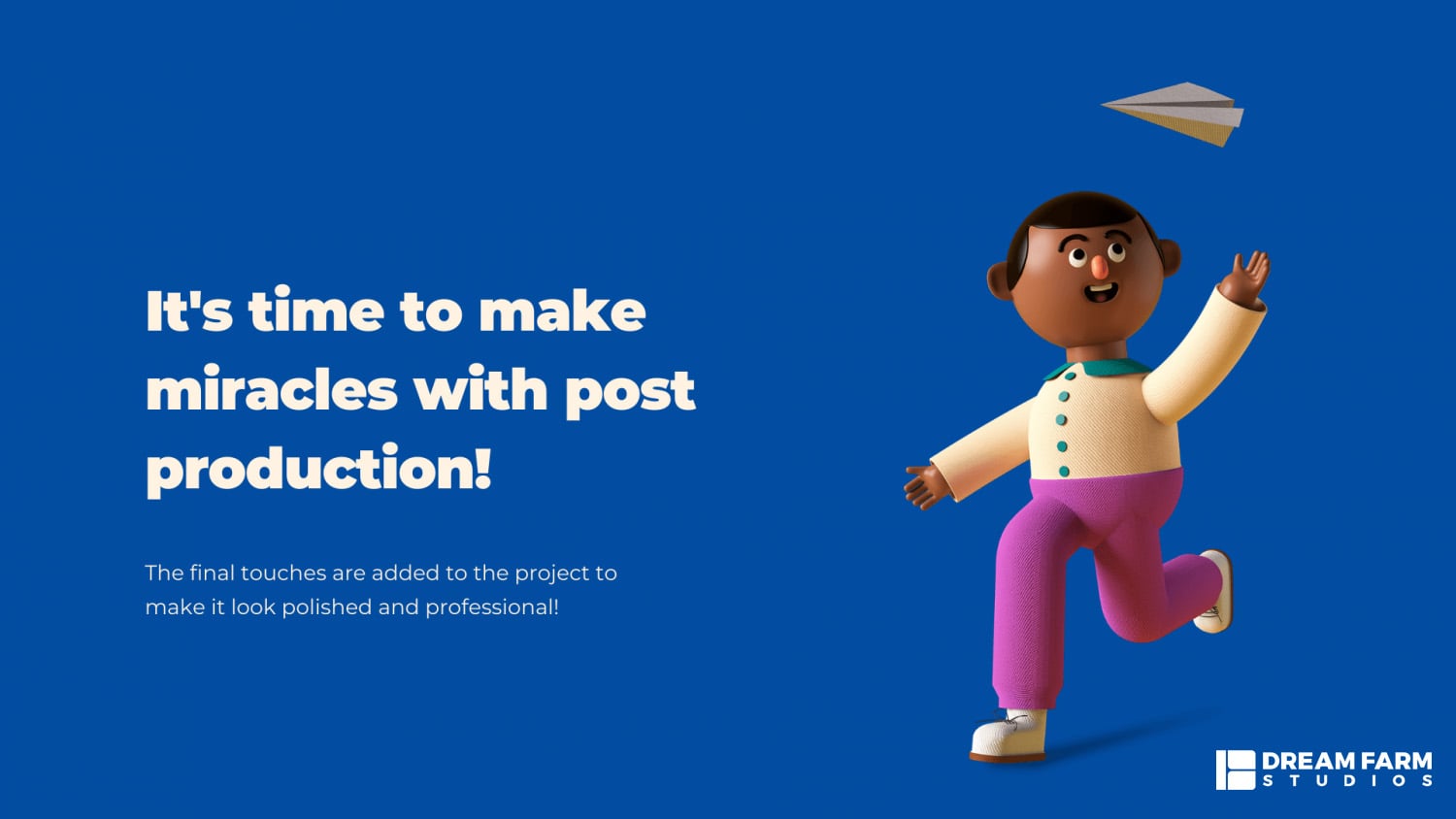
What is the difference between 3D animation and CGI pipeline?
CGI stands for Computer-generated imagery and is defined as using computer graphics to make or utilize images in art, game art, feature films, and series, TV series, commercials, etc. There’s no difference between CGI and 3D animation as both use the same techniques and methods to create and use art in different ways.
If you want to know about the 2D animation pipeline, check out our other article about the 2D animation production process.
Why do we use a pipeline for 3D animation production?
You can picture the 3D animation pipeline as a creative assembly line in which everything is planned out, from conception to publishing. The entire pipeline might consist of as many as 500 artists or as few as 2. The most significant point of having a workflow in place is that every single one of these artists must know what, when and how exactly the tasks in hand should be done and handed out to the next artist or group of artists.
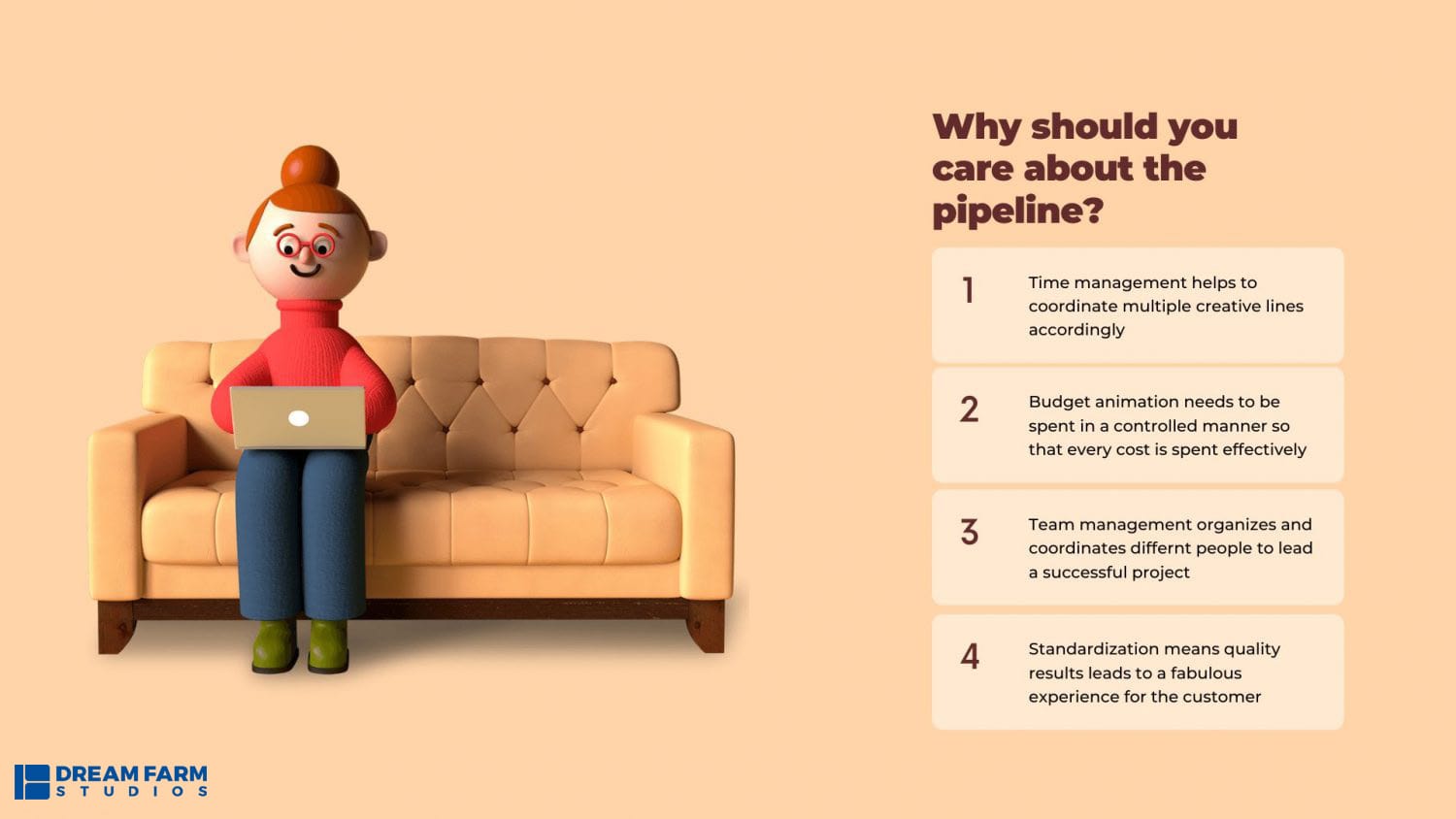
Generally, there are 4 main reasons for using a pipeline in 3D animation production:
-
Time management:
Producing 3D animation, especially feature films and 3D animated series, is a complex and time-consuming endeavor in nature. When accumulated, even minor micro-delays in each step can postpone the outcome and lead the whole project towards a financial disaster created by a domino effect. So there needs to be a detailed time frame for each step and a grand plan to coordinate multiple creative lines accordingly; some of which are supposed to be done simultaneously.
-
Budget management:
Although depending on multiple factors 3D animation costs and budgets might vary, most of the time a significant amount of money is involved and it needs to be spent in a controlled manner to be effective. The ROI of most 3D animation projects is calculated before the production is started.
-
Team management:
The number of people involved in an animation project can be as much as 500. These people are usually split into multiple teams and groups, most of which must work in coordination for the project to be successful. The significance of managing these teams and individuals with different responsibilities and skills is something you don’t want to ignore at all.
-
Structuring and standardization:
A thought-out pipeline is the most efficient way to make sure everyone is on the same page, and working towards the same goal. Moreover, professional animation studios like Dream Farm produce hundreds of 3D animations per year for a variety of clients. Making sure each and every one of these animations are created with an adequate amount of precision and quality and providing the clients with the same fabulous experience every time can definitely set you apart from the competition, bringing in even more clients.
How to get started in animation production (FAQ)
Let’s look at some of the questions that our readers have asked after reading our blog. We’ve listed the questions with short answers to get you going.
1. What do I need to get started in animation production?
The bare minimum is a mid-range computer (or something a bit beefier if you have your heart set on 3D animation) and some animation software plus a great deal of passion for learning animation.
2. Do you need to know how to draw to be a good animator?
Not necessarily but it certainly helps, especially if you’re working for a smaller studio where lots of jobs in the animation pipeline are your responsibility. Design, character creation, storyboarding and other artistic elements of putting an animation together will be impossible for you if you can barely cobble together a stick person.
3. How is animation a career?
It can be tough, isolating, competitive and repetitive, but that’s exactly why you need to have a passion and a love for what you do.
Animation is also immensely rewarding and inspiring. It gives you a chance to be creative and remain on the forefront of technological development; the people are amazing and with the entertainment industry, it’s always interesting.
4. How do you make a great animation portfolio?
Your portfolio is you. It represents who you are as an artist so it needs to contain your very best work and demonstrate your varied skills in a short amount of time. No pressure. Here’s our quick set of tips for creating an amazing animation demo reel:
- 30-45 seconds. Chances are, the person looking through your portfolio has a long list to get through and has watched hours of portfolio footage in their time, keep it snappy and be ruthless with what makes the cut.
- Simple to navigate. Stick to Vimeo.
- Multiple short clips. These will keep the viewer’s attention with their momentum and variety, giving you the opportunity to show off the different styles and mediums you’re great at.
Summary
Creating a 3D animation is a complicated process involving a lengthy list of tasks, a comprehensive set of hardware, and a large group of people with different skills and responsibilities. In order to keep the process flowing efficiently and affordably, a solid production workflow is needed.
A 3D animation pipeline is a system consisting of people, hardware, and software aligned to work in a specific sequential order to do pre-determined tasks in a pre-determined timeframe. Sticking to this procedure will lead to a 3D animation product or asset as the final output, such as a 3D feature film, short animation, television show, 3D video game asset, or else.
IF YOU HAVE ANY QUESTIONS REGARDING ANIMATION PIPELINE OR ANIAMTION AS A CAREER, DROPS US A COMMENT DOWN BELOW AND WE ADD IT HERE WITH AN ANSWER!

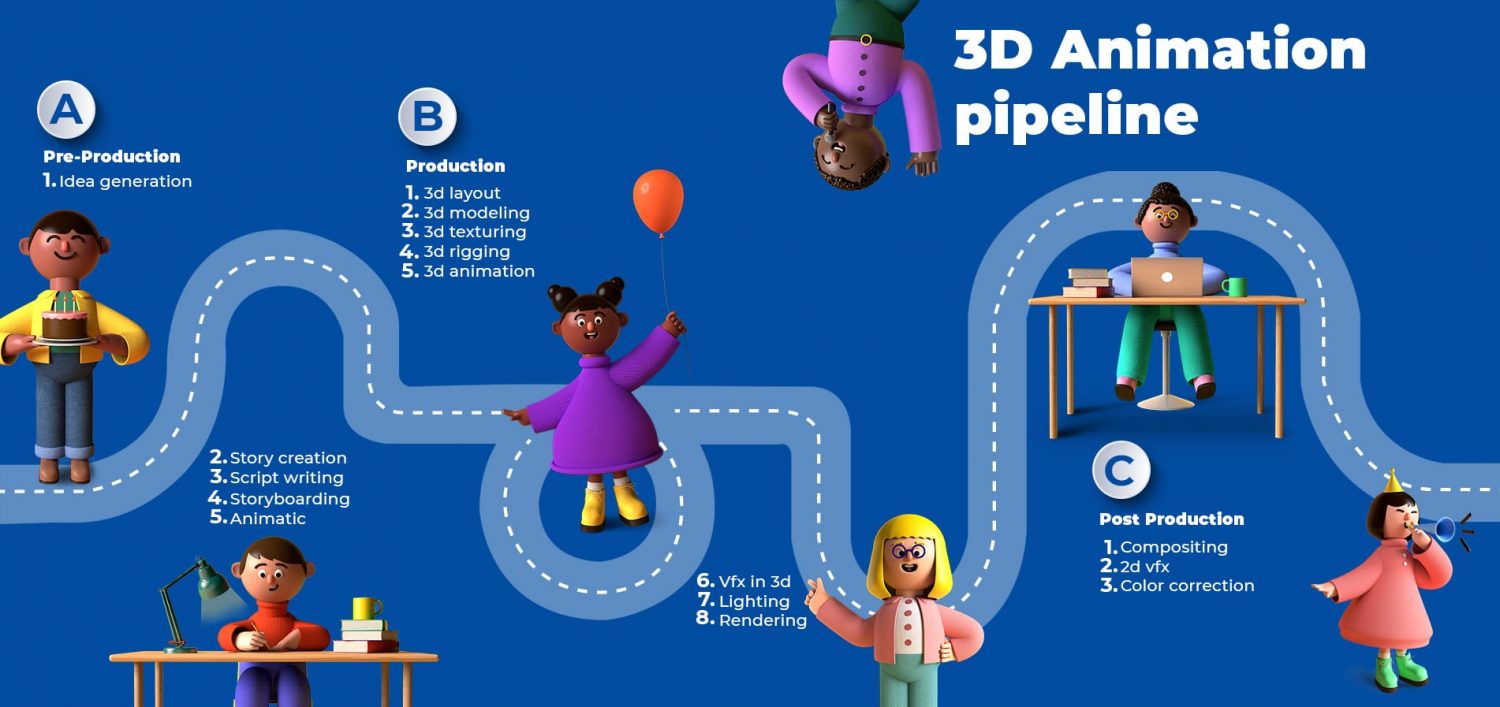


thanks for your great article, its so helpful!
I’m glad you liked it Kaveh! Make sure you come back again, I’ll keep producing more content and update the 3D pipeline article for nice folks like you!
can you give me a link if you had a specific page about the 3d pipeline.
Hello Mulagada. This page is our article about the 3D animation pipeline. For more information about the different stages of the pipeline, you can browse the first part of this blog and choose your next article!
very interesting article it’s great to learn more on 3d animation
Thank you Mauricio. I’m continuously updating our blog. Make sure you check on our new posts and leave comments more often! 😉
You explained everything in detail in this article about 3d animation studios
Hope you liked it Aaron 🙂
Great break down. Just wanted to know if different animation companies work with different animation pipelines
I would very much appreciate your informative article. Is it possible that we outsource the pre production stage of a 3d animation to a company and then we take care of the rest?
very helpful article
Thrilled to hear that. Thank you Mona
thanks for all your efforts to make this guidings ,it`s so helpfull for a begginer.
Thank you very much Riddhi, always keep checking out our blog for more educational stuff.
Great break down and easy to understand materials. Please write about each part of the pipeline separately.
A lot of animation studios neglect the use of traditional CGI pipeline and instead try to come up with their own workflow. What do you think is the result of such action? Is it ok to skip some parts of the traditional pipeline?
thanks for your great article, its so helpful!
Thank you very much hninhnin, check out our other articles too.
One of the best guides for absolute beginners who are trying to find a career that compliments their passion for film, technology, design, coding, and digital art. very informative! This blog will give you a good overview of the animation industry and the career prospects available to you. so, It’s really up to us, how we need to take the next step using the advice provided in this guide.
Thanks. Check out our other articles.
This is absolutely one of the best articles I’ve come across about animation production pipeline.
Thx Nadia, most appreciated.
Can i know where can i find these kind of 3d animation pipeline on canva pro. I want the keyword to find these
Hi there Palak, I’ll ask our design team about the source of the images but I guess they’ve made some adjustments and refinings too.
Wow,Really Great Post about animation pipline. Its very helpful article.
Thank you very much Rnw, feel free to check out our other blog posts 🙂
Hello there, I´m a student of network and computer systems administration and working on a small project. Its about how I would install a network for an animation studio theoretically. This blog has been really usefull till now, thank you. I do have a question though, how many devices are needed for each step of the pipeline? I know it must vary a lot from studio to studio, so in your studios case how many computers are there working in each process?
Hi there David, thank you for your attention. We’re happy to be a part of your valuable project. In the case of devices required for animation, in most cases, each step of the process needs one device. However, it depends on the scale of the project.
Great article thanks a lot
Thx a lot Tony, really appreciate it. If you liked this article, you might like our 2d animation production workflow too.
Helpful and very interesting article. Great to add more knowledge about 3D animation. Thanks for sharing this.
Thank you for letting us know FarageFarm. If you’re interested, check out our complete guide on 2d animation pipeline.
The way of writing about this blog is Impressive!
Hi, This is a really informative article and has helped me to understand the process a lot more. My main question would be, how long does a 1 minute medium complexity animation take from start to finish?
Hi Nathan, thanks for dropping by. making a 3d animation could range from a few hours to several days or months depending on the subject matter and complexity of the animation. However, To give you a rough idea, A complex fight scene or another detailed scenario (crowd running, castle siege, etc) involving multiple characters, you could be looking at a couple of days, if not weeks or months, depending once again on the design and style of the characters and overall animation.
Hope that helps 🙂
Very informative and useful writing. I benefited a lot.
Great blog, but voice over wasn’t mentioned here. Do you record the voices before animation, or animate before recording
I find this blog very informative, keep up the good work.
Thanks for the valuable information. I would like to know, configuration of the computer to run, use practice 3D modeling in blender software?
Thanks for sharing such a good concept which you present it’s really good and understanding for everyone. I am a new person in the animation field so that is why I join Merciless Nature they educate me on all types of animation so can you check out for me and guide me its good and not waiting for you response
This blog is very helpful and thank you for provide infromation.
Thanks for your comment. Happy to help 🙂
This is a great guide for rookies, when I was starting I had a very poor budget and time management… in the ended up using a tool that is promoted a lot in the 3d field, a render farm.
On a side note, have you thought about doing an article comparing the best ones to use? I mean I’m currently using https://rebusfarm.net/ and I’m really happy with it but I just want to read what else is there
Hey Amaya. Thanks for your comment! So glad you liked the article and it helped you! ✌😉
Excellent explanation of this complicated process. Very complete and clear. Thank you!
Makes us proud to know, Muriel! 🙏✨
Thanks for providing this helpful guide. It is really very informative.
A cohesive and comprehensive breakdown of the 3d animation pipeline. Thank you.
I’m genuinely impressed by the quality of your blog – it’s informative, engaging, and incredibly well-written!
I’m genuinely impressed by the quality of your content –nice one, keep sharing
I’m genuinely impressed by the quality of your content –nice one, keep sharing
Very informative article! Was wondering in what capacity one would be allowed to use this work for say, teaching purposes?
Thank you for your positive feedback on the article, and I appreciate your inquiry about using it for teaching purposes. In this case, if you plan to use the article as a reference or resource for teaching, providing a link to the main article is often a respectful and ethical approach. It allows your students or audience to access the original source for a more comprehensive understanding.